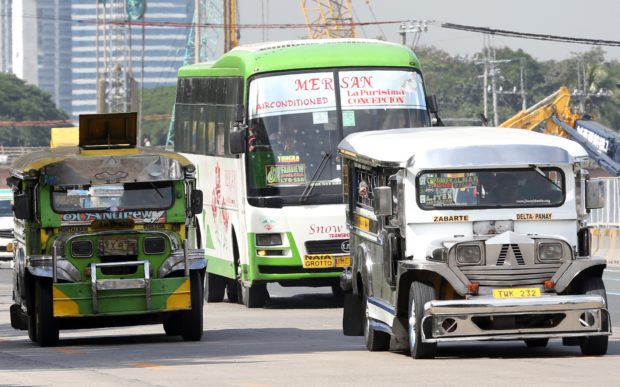MANILA, Philippines — As if the lack of public transport especially during the peak periods of the day is not enough, weary commuters face the possibility of paying more when riding jeepneys and buses to and from work during rush hour.
The Land Transportation Franchising and Regulatory Board (LTFRB) on Tuesday held the first hearing on a petition filed last month by transport groups seeking a surcharge during rush hours for jeepneys and buses due to rising fuel prices.
In a 42-page petition filed on Oct. 14, transport groups asked the LTFRB to allow traditional and modern jeepneys to charge every passenger an additional P1, and P2 for public buses, during the rush hour periods from 5-8 a.m. and 4-8 p.m., except on Sundays and national holidays.
The surge pricing will be on top of the transport modes’ base or minimum fares. Last September, the LTFRB approved a fare increase petition that raised by P1 the minimum fare to P12 for the first four kilometers for traditional jeepneys and to P14 for modern jeepneys.
The basic fare for public utility buses in Metro Manila was also raised by P2 for the first five kilometers to P13 for ordinary and P15 for aircon, and to P11 for ordinary provincial buses. The flag-down rates of taxis and the transport network vehicle services (TNVS) or ride-hailing apps was increased by P5.
The petition for a rush-hour surcharge was field by Pasang Masda, Alliance of Transport Operators and Drivers Association of the Philippines, and Alliance of Concerned Transport Organization.
Next hearing in 2023
Nichelle Ann Cabog-Bergonia, the transport groups’ private counsel, said that during Tuesday’s hearing, they requested from the LTFRB a 30-day period to present a memorandum outlining their position.
The lawyer said the next hearing would be held on Feb. 2 next year, but no witnesses or additional evidence would be presented.
In their surcharge petition, the transport groups said the recent fare increases were “not enough to alleviate the woes of public utility vehicle operators in the face of further fuel price hikes, higher operational costs caused by inflation, and also due to rush congestion in the city.”
Four days after the groups filed the petition, the LTFRB said it would study the petition as it recognized the call of public utility drivers and operators for an additional fare increase.
Transportation Secretary Jaime Bautista has also said that the request for a surge pricing for public transportation was “logical.” He did not elaborate.
The LTFRB earlier assured public utility vehicle (PUV) drivers and operators that their petition would be heard in the wake of the continued rise of fuel prices.
It said it understood the arguments raised by the transport groups, especially the concern to increase the earning of drivers and conductors.
In hearing the new petition of transport groups for a rush-hour surcharge, however, the LTFRB noted that the plight of commuters must also be heard, especially after the recent fare increases.
Shrinking income
The steep increase in prices of gasoline and diesel had eaten into the earnings of PUV drivers and operators, many of them choosing to look for other work or additional jobs to increase their income.
Even those outside Metro Manila have complained about the impact of rising fuel prices on their livelihood.
Jeepney drivers in Luzon provinces, for instance, are struggling to bring home enough money for their families after a day on the road due to rising fuel prices, forcing them to take on odd jobs and find other ways to cope with the crisis.
Cris Mira, chair of the transport group Kaisahan ng mga Sasakyang Namamasada sa Bataan (Kasakbayan), said many jeepney drivers were feeling the crunch as they found it hard to pay their operators under the traditional boundary (daily lease) scheme.
“They (drivers) would be lucky if they could pay a boundary of P300. Their supposed take-home income is spent on fuel,” Mira told the Inquirer in an interview on Tuesday.
He said many of his group’s members had been forced to find temporary jobs on construction sites.
